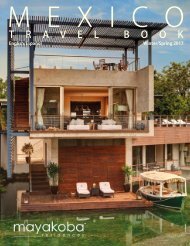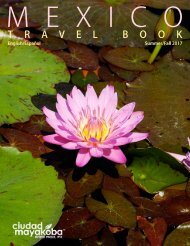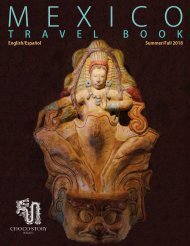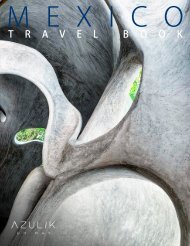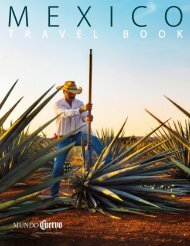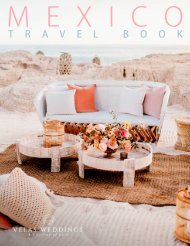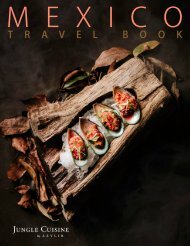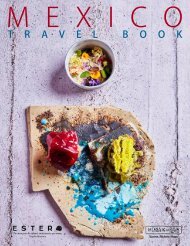Mexico Travel Book Winter-Spring 2016
This beautiful country is full of poetry and magic, and the talents and hospitality of the people is experienced by every visitor. In our magazine we invite you to get to know Mexico and to visit it. We offer a glimpse into a new world with interesting information, culture and much more! Este hermoso país está lleno de poesía y magia, y los talentos y la hospitalidad de la gente es experimentada por todos los visitantes. En nuestra revista le invitamos a conocer México y para visitarla. Ofrecemos una visión de un nuevo mundo con información interesante, cultura y mucho más!
This beautiful country is full of poetry and magic, and the talents and hospitality of the people is experienced by every visitor. In our magazine we invite you to get to know Mexico and to visit it. We offer a glimpse into a new world with interesting information, culture and much more!
Este hermoso país está lleno de poesía y magia, y los talentos y la hospitalidad de la gente es experimentada por todos los visitantes. En nuestra revista le invitamos a conocer México y para visitarla. Ofrecemos una visión de un nuevo mundo con información interesante, cultura y mucho más!
Create successful ePaper yourself
Turn your PDF publications into a flip-book with our unique Google optimized e-Paper software.
M E X I C O<br />
T R A V E L B O O K<br />
English/Español<br />
<strong>Winter</strong>/<strong>Spring</strong> <strong>2016</strong>
acebook.com/<strong>Mexico</strong><strong>Travel</strong><strong>Book</strong>
CONTENT<br />
World’s Largest 3D Musuem<br />
El Museo 3D Más Grande del Mundo 3<br />
The Timeless Charm of the Yucatan Peninsula<br />
El Encanto Intemporal de la Península de Yucatán 10<br />
Mayapan 26<br />
Ancient wall painting in Mayapan<br />
Pintura mural antigua en Mayapán<br />
Mexican Folk Art<br />
Arte Popular Mexicano 38<br />
Tamales Gourmet Style on the Menu<br />
Tamales Estilo Gourmet en el Menú 64<br />
A Creative Approach to Yucatecan Cuisine<br />
Un Enfoque Artístico para Cocina Yucateca 56<br />
Pescado Tikin Xic<br />
Frida, Gran Velas<br />
Mayan Musical Instruments<br />
Instrumentos Musicales Mayas 74<br />
Beware of Crocodiles<br />
Cuidado con Cocodrilos 80<br />
Rally Maya <strong>2016</strong> 94<br />
Crocodiles enjoy sunbathing<br />
Cocodrilos disfrutan de tomar el sol<br />
Calendar<br />
Calendario 90<br />
Rally maya <strong>2016</strong>, Yucatan<br />
4
Visit us online to view the digital version!<br />
¡Visítenos en línea para ver la versión digital!<br />
facebook.com/<strong>Mexico</strong><strong>Travel</strong><strong>Book</strong><br />
Welcome to <strong>Mexico</strong>!<br />
¡Bienvenido a <strong>Mexico</strong>!<br />
This beautiful country is full of poetry and magic,<br />
and the talents and hospitality of the people is<br />
experienced by every visitor. In our magazine we<br />
invite you to get to know <strong>Mexico</strong> and to visit it.<br />
We invite you to check out <strong>Mexico</strong> <strong>Travel</strong> <strong>Book</strong><br />
online and to pick up your free copy upon arrival.<br />
Este hermoso país está lleno de poesía y magia,<br />
y los talentos y la hospitalidad de la gente es<br />
experimentada por todos los visitantes. En<br />
nuestra revista le invitamos a conocer México y<br />
para visitarla.<br />
Les invitamos a difrutar la revista <strong>Mexico</strong> <strong>Travel</strong><br />
<strong>Book</strong> en los redes sociales y llevar su copia<br />
gratuita a su llegada.<br />
6<br />
Svetlana Aleksandroff<br />
Editorial Director/Publisher<br />
facebook.com/<strong>Mexico</strong><strong>Travel</strong><strong>Book</strong><br />
mexicotravelbook@gmail.com
The Timeless Charm of the Yucatan Peninsula<br />
El Encanto Intemporal de la Península de Yucatán<br />
8
Occupying only 2% of the country’s territory,<br />
the Yucatan peninsula welcomes more tourists<br />
each year than any other part of <strong>Mexico</strong>.<br />
Yucatan really has a lot to offer.<br />
Located between the Caribbean Sea and Gulf<br />
of <strong>Mexico</strong>, it is made of 3 states – Campeche,<br />
Quintana Roo and Yucatan, and has a population<br />
of 2 million. Historically the peninsula<br />
had significant chicle and henequen production<br />
on hacienda estates. In the 1970s the<br />
Yucatán Peninsula has changed its economy<br />
towards tourism, and now is steadily moving<br />
towards eco and luxury tourism in a new<br />
trend of combining the best of both.<br />
Ocupando sólo el 2% del territorio del país,<br />
la península de Yucatán recibe más turistas<br />
cada año que cualquier otra parte de México.<br />
Yucatán realmente tiene mucho que ofrecer.<br />
Situado entre el Mar Caribe y el Golfo de<br />
México, está hecho de 3 estados - Campeche,<br />
Quintana Roo y Yucatán, y tiene una población<br />
de 2 millones. Históricamente la<br />
península tenía chicle y henequén producción<br />
significativa en las haciendas. En la década<br />
de 1970 la península de Yucatán ha cambiado<br />
su economía y ahora está moviendo constantemente<br />
hacia el turismo ecológico y de lujo<br />
en una nueva tendencia de combinar lo mejor<br />
de ambos.<br />
9
Nature is the Main Attraction<br />
Tropical jungle and mangroves are home to 465 bird<br />
species. Coastal dunes, coral reefs and subterranean<br />
river systems with its diverse flora and fauna create a<br />
favorable background for eco-friendly adventures.<br />
Highly recommended by <strong>Mexico</strong> <strong>Travel</strong> <strong>Book</strong> - three<br />
large natural reserves Sian Kaan, Celestun, Calakmul.<br />
The Ria Celestun park - less than 2 hours drive from<br />
Merida, has a rare population of wild flamingoes<br />
and other aquatic birds. The town of Celestun is best<br />
known for its fresh seafood and the best eco-hotel in<br />
<strong>Mexico</strong> – hotel Xixim.<br />
The Sian Ka’an Biosphere, just south of Tulum, a place<br />
to explore lagoons, coral reefs, rainforest and to discover<br />
unknown Mayan cites.<br />
Calakmul located in the south-east and deep in the<br />
jungle, is the largest tropical forest reserve in <strong>Mexico</strong><br />
with over 1000 varieties of plants. The Calakmul<br />
archeological site is characterized by well-preserved<br />
buildings and temples of an ancient Maya capital.<br />
La Naturaleza es la Atracción Principal<br />
La selva tropical y los manglares son el hogar de 465<br />
especies de aves. Dunas costeras, arrecifes de coral y<br />
los sistemas de ríos subterráneos con su diversa flora<br />
y fauna crean un fondo favorable para eco-aventuras.<br />
Altamente recomendado por la revista <strong>Mexico</strong> <strong>Travel</strong><br />
<strong>Book</strong> - tres grandes reservas naturales de Sian Kaan,<br />
Celestún y Calakmul.<br />
Ría Celestún - menos de 2 horas en coche de Mérida,<br />
tiene una población de flamencos y otras aves acuáticas.<br />
La localidad de Celestún es mejor conocido por<br />
sus mariscos frescos y el mejor ecohotel en México -<br />
hotel Xixim.<br />
10<br />
La Biosfera de Sian Ka’an, al sur de Tulum, es un lugar<br />
para explorar lagunas, arrecifes de coral, la selva y<br />
descubrir desconocidos pueblos maya.<br />
Calakmul, ubicado en el sur-este y profundo de la<br />
selva, es la mayor reserva de bosques tropicales en<br />
México con más de 1.000 variedades de plantas. El<br />
sitio arqueológico de Calakmul se caracteriza por<br />
edificios y templos de una antigua capital maya bien<br />
conservados.
Ancient Mayan archeological sites,<br />
enchanting colonial cities, romantic<br />
haciendas and colonial towns, along<br />
with distinct regional cuisines make<br />
the Yucatan Peninsula the best<br />
vacation destination.<br />
Places of interest: Hacienda Sotuta<br />
de Peon, Choco Story cacao museum<br />
in Uxmal, magical towns Valladolid<br />
and Izamal.<br />
Campeche<br />
12
Sitios antiguos mayas arqueológicos,<br />
ciudades coloniales encantadoras,<br />
haciendas románticas y pueblos coloniales,<br />
cocinas regionales distintas<br />
hacen que la Península de Yucatán es<br />
el mejor destino de vacaciones.<br />
Lugares de interés: Hacienda Sotuta<br />
de Peon, Choco Story museo del<br />
cacao en Uxmal, pueblos mágicos<br />
Valladolid y Izamal.<br />
Yucatan<br />
13
Welcome to Hacienda Sotuta de Peón!<br />
¡Bienvenidos a la Hacienda Sotuta de Peón!<br />
Hacienda Sotuta de Peón, built in the late 1800‘s in<br />
Tecoh, Yucatán is a unique project and the only fully<br />
operational Henequen Hacienda in <strong>Mexico</strong>, reflecting<br />
the grand style, elegance and tradition of this period.<br />
Visitors literally travel back in time, transported on<br />
wooden platforms pulled by ‘mules’ over Decauville<br />
rails imported from France, witnessing the step-bystep<br />
process of turning Henequen (or Green Gold<br />
of Yucatan), from plant to fiber to finished product,<br />
followed by a visit to a typical Mayan House and a<br />
swim in a cenote.<br />
The name of Sotuta is derived from the Maya term<br />
“Tzu Tzut Ha” or ‘moving water’ and one of the most<br />
spectacular cenotes is called Dzul-Ha (towels, masks<br />
and life jacket supplied).<br />
The restaurant showcases the excellent quality of Yucatecan<br />
cuisine complemented by attentive service.<br />
The Hacienda Sotuta de Peon has everything necessary<br />
for weddings, corporate events and conventions.<br />
Bienvenidos a la Hacienda Sotuta de Peón, construida<br />
a finales del siglo XIX en Tecoh, Yucatán.<br />
Sotuta de Peón es el proyecto de restauración ubicado<br />
en el corazón de la antigua zona henequenera del<br />
estado de Yucatán.<br />
Cuando pasean por Sotuta de Peón, nuestros visitantes<br />
literalmente viajan en el tiempo, transportados<br />
en plataformas de madera las cuales son tiradas<br />
por “mulas” sobre rieles de Decauville importados de<br />
Francia. Aquí, usted podrá ser testigo de cada paso<br />
del proceso de transformación del Henequén (también<br />
llamado Oro Verde en esta región), de la planta<br />
al producto terminado.<br />
Y añada a esto las inigualables formaciones geológicas<br />
de nuestras atracciones secretas, el Cenote, unos<br />
hermosos ríos de aguas cristalinas y alcalina.<br />
El restaurante presenta la excelente calidad de la cocina<br />
yucateca complementado con un servicio atento.<br />
La Hacienda Sotuta de Peón tiene todo lo necesario<br />
para bodas, eventos corporativos y convenciones.
Kabah Archeological Site<br />
16
Sitio Arqueológico Kabah<br />
17
Kabah is located 23 km southeast of Uxmal near the<br />
town of Ticul, and the name has been interpreted as<br />
“strong hand” and is believed to be an important city<br />
after Uxmal.<br />
An ancient 20 km long road called sacbé 20 km<br />
connects Kabah with Uxmal. It is assumed that the<br />
sites of the Puuc region cover the period of 600-900<br />
A.D., but it is undeniable that sites such as Kabah go<br />
back at least to the Early Classic. The most important<br />
building Codz Pop shows the facade composed of a<br />
succession of masks of the god Chaac.<br />
Monday to Sunday from 8:00 to 17:00 hours.<br />
General admission: 50 pesos.<br />
18
Kabah se localiza a 23 km al sureste de Uxmal cerca<br />
de la ciudad de Ticul, y el nombre se ha interpretado<br />
como “la mano poderosa” y se cree que fue un sitio<br />
importante como Uxmal.<br />
Un camino llamado sacbé de 20 km conecta a Kabah<br />
con Uxmal. Se asume que los sitios de la Región Puuc<br />
ocupan una temporalidad de 600 a 900 d.C., pero es<br />
innegable que sitios como Kabah se remontan por lo<br />
menos al Clásico Temprano. El edificio más importante<br />
Codz Pop muestra la fachada compuesta por una<br />
sucesión de mascarones del dios Chaac.<br />
Lunes a Domingo de 08:00 a 17:00 horas.<br />
Entrada general: 50 pesos.<br />
19
Travesía Sagrada Maya<br />
20
21
22<br />
Cozumel
Puerto Morelos<br />
Cancun and Riviera Maya, with seafront<br />
resorts, beautiful white sandy<br />
beaches and exhilarating adventures<br />
allow for one-of-a-kind experiences.<br />
The thousands of sinkholes known<br />
as cenotes throughout the peninsula<br />
provide access to the subterranean<br />
river system.<br />
Cancún y Riviera Maya, con los<br />
centros turísticos frente al mar,<br />
hermosas playas de arena blanca y<br />
emocionantes aventuras permiten las<br />
experiencias únicas. Los miles de cenotes<br />
conocidos en toda la península<br />
proporcionan acceso al sistema de<br />
ríos subterráneos.<br />
23 Riviera Maya
Mayapan<br />
The last capital of the Mayan kingdom founded by the mythical god-like hero<br />
Kukulkan, where he is believed to have fled after the fall of Chichen Itza.<br />
24
Mayapan<br />
La última capital del reino maya fundada por el dios y héroe mítico Kukulkán,<br />
donde se cree que habia ido tras la caída de Chichén Itzá.<br />
25
Located about 50 km southeast of Mérida, state<br />
of Yucatán, Mayapan become a very important city<br />
between 900 and 1450 AD. The history of Mayapan is<br />
linked to Chichén Itzá and the style of art and architecture<br />
demonstrate a strong evidence of trade and<br />
exchange in Central America, including the mainland<br />
of modern day <strong>Mexico</strong> and all the way to Yucatan and<br />
the Caribbean coast.<br />
The main temple is the Pyramid of Kukulkan, 15 m<br />
tall, built over a cave. Mayapan is also known for its<br />
murals and stucco reliefs.<br />
26<br />
The city was walled and over 3000 structures have<br />
been discovered so far. One of the most impressive<br />
building is the circular observatory. The Maya were<br />
very skilled astronomers and accurately recorded and<br />
calculated the movements of Venus and other planets.<br />
A visit to the city of Mayapan is a wonderful day trip<br />
from Merida, it is open daily, has parking and some<br />
authentic sights along the way.
Situado a unos 50 km al sureste de Mérida, estado<br />
de Yucatán, Mayapán se convirtió en una ciudad<br />
muy importante entre 900 y 1450 d.C. La historia de<br />
Mayapán está vinculada a Chichén Itzá y el estilo de<br />
arte y arquitectura demuestra una fuerte evidencia de<br />
comercio e intercambio en América Central, incluyendo<br />
la parte continental de hoy y todo el camino a<br />
Yucatán y la costa del Caribe.<br />
El templo principal es la Pirámide de Kukulkán, a 15 m<br />
de altura, construida sobre una cueva. Mayapán también<br />
es conocido por sus murales y relieves de estuco.<br />
La ciudad fue amurallada y más de 3.000 estructuras<br />
se han descubierto hasta ahora. Uno de los más<br />
impresionantes es el observatorio circular. Los mayas<br />
fueron astrónomos muy cualificados y registraron y<br />
calcularon los movimientos de Venus y otros planetas<br />
con precisión.<br />
Una visita a la ciudad de Mayapán es un viaje maravilloso<br />
de Mérida, esta abierto todos los días, tiene<br />
estacionamiento y algunos lugares bonitos en el<br />
camino.<br />
27
Shopping<br />
Compras
Huichol Art<br />
The Huichol people live in the Western<br />
part of the Sierra Madre Mountains, in the<br />
states of Jalisco and Nayarit, keeping their<br />
ancient culture. They became famous for<br />
their interesting art – considered to be the<br />
expression of the visions witnessed during<br />
the shamanic Peyote ceremonies.<br />
These unique designs are created by placing<br />
layers of glass beads upon a wooden<br />
surface covered with a thin layer of special<br />
resin. The objects may be animals or<br />
plants, masks or dishes.<br />
Arte Huichol<br />
Los Huicholes viven en la parte occidental<br />
de la Sierra Madre, en los estados de<br />
Jalisco y Nayarit, manteniendo su antigua<br />
cultura. Se hicieron famosos por su interesante<br />
arte - considerada como la expresión<br />
de las visiones de testigos durante<br />
las ceremonias chamánicas Peyote.<br />
Estos diseños únicos se crean mediante<br />
la colocación de capas de perlas de vidrio<br />
sobre la superficie de madera cubierto<br />
con una fina capa de resina especial. Los<br />
objetos pueden ser animales o plantas,<br />
máscaras o platos.<br />
30
Art and crafts galleries<br />
in Riviera Maya<br />
Galerías de arte y artesanía<br />
en Riviera Maya<br />
5ta Hacienda Art Gallery<br />
The best eclectic collection of<br />
Mexican art in Playa del Carmen<br />
La mejor colección de arte<br />
mexicano en Playa del Carmen<br />
5ta ave. & calle 40<br />
9 am – 9 pm<br />
Playa del Carmen<br />
Silvia Suarez Boutique<br />
Unique designs, high quality<br />
embroidery from Oaxaca<br />
Diseños únicos, bordados de<br />
alta calidad de Oaxaca<br />
5 ave entre calle 34 y calle 38<br />
Playa del Carmen<br />
Hamacamarte<br />
Hammocks from all over the world,<br />
in all colors, sizes and shapes<br />
Hamacas de todo el mundo, en<br />
todos los colores, tamaños y formas<br />
Calle 38 Entre 5ta & la playa<br />
Mon/Lun - Sat/Sab: 10:00 am - 6:00 pm<br />
Sun/Dom: 10:00 am - 2:00 pm<br />
Playa del Carmen<br />
Lamanai Gallery<br />
A unique collection of arts and<br />
crafts & beautifully designed jewelry<br />
Una colección única de arte y artesanía<br />
& joyería bellamente diseñado<br />
www.galerialamanai.mfbiz.com<br />
Mon/Lun - Sun/Dom: 8:00 am - 9:00 pm<br />
Akumal<br />
32<br />
Museo del Arte<br />
Popular Mexicano<br />
Hacienda Henequenera – an<br />
amazing collection of arts and<br />
crafts from all over <strong>Mexico</strong><br />
Hacienda Henequenera - una<br />
impresionante colección de arte y<br />
artesanías de todo México<br />
www.experienciasxcaret.com
Mexican Folk Art<br />
Arte Popular Mexicano<br />
36
Mata<br />
Ortiz<br />
38
Mata Ortiz, the finest and most original pottery, bears<br />
the name of a small town in Northen Chihuahua.<br />
Building up on the traditions Casa Grande of Paquime,<br />
a self-taught artist Juan Quezada started the trend<br />
in the 70’s, finding a unique artistic expression using<br />
ancestral symbols, and creating unique contemporary<br />
art.<br />
Mata Ortiz ceramics are hand built without the use of<br />
a potter’s wheel and are shaped, polished and decorated<br />
by hand. Most tools and raw materials are local.<br />
A creative desire supported by a cultural tradition resulted<br />
in a creation of a unique product appreciated by<br />
collectors all over the world.<br />
Now the entire pueblito of Mata Ortiz makes outstanding<br />
handmade pieces following centuries old<br />
methods.<br />
Mata Ortiz, la cerámica más fina y más original, lleva<br />
el nombre de un pequeño pueblo en el norte de Chihuahua.<br />
La construcción de las tradiciones de Casa<br />
Grande de Paquimé, un artista autodidacta Juan<br />
Quezada inició la tendencia en el 70s, la búsqueda de<br />
una expresión artística única utilizando los símbolos<br />
ancestrales, y la creación de arte contemporáneo único.<br />
La cerámica de Mata Ortiz son construidas sin el uso<br />
de un torno de alfarero mano y tienen la forma, pulido<br />
y decoradas a mano. La mayoría de las herramientas<br />
y las materias primas son locales.<br />
Un deseo creativo apoyado por una tradición cultural<br />
dio como resultado una creación de un producto único<br />
apreciado por los coleccionistas de todo el mundo.<br />
Ahora todo el pueblito de Mata Ortiz hace piezas<br />
hechas a mano pendientes utilizando métodos de siglos<br />
de antigüedad. 39
Tree of Life<br />
A Tree of Life is an old folk tradition, and only about a dozen of artisan’s dynasties in <strong>Mexico</strong> are making them<br />
in Metepec, Toluca, and Puebla. The first Trees of Life were used as wedding gifts depicting the Garden of<br />
Eden. The pieces are hand molded from local clay and are fired in a wood kiln. After firing, they are coated in<br />
white paint and then painted with bright colors including natural pigments like indigo for blue and cochineal<br />
for red, and some Trees of Life are left unpainted. Size may be from a few cm to 4 meters.<br />
40
Arbol de Vida<br />
Jose Luis Serrano<br />
Un árbol de la vida es una tradición popular y antigua, y sólo alrededor de una docena dinastías de artesanos<br />
dinastías en México están haciendo los en Metepec y Puebla. Los primeros árboles de la vida fueron utilizados<br />
como regalos de boda que representaron el Jardín del Edén. Las piezas se moldean a mano de la arcilla local<br />
y se cuecen en un horno de leña. Después de la cocción, están recubiertos con pintura blanca y luego pintadas<br />
con colores vivos de los pigmentos naturales como el añil de azul y cochinilla para el rojo, y algunos árboles de<br />
la vida se quedan sin pintar. El tamaño puede ser desde unos pocos cm a 4 metros.<br />
41
Among many ceramic artists there are two<br />
that stand out as creators of their unique<br />
styles of the Tree of Life.<br />
Maestro Alfonso Castillo Orta, a fourth generation<br />
potter who started at his family’s<br />
workshop at the age of 12 in Izúcar de Matamoros,<br />
in the state of Puebla, experimented<br />
with many techniques and created his<br />
own style bringing in many different themes,<br />
like Catrinas, angels, flowers, dishes, musicians<br />
and made candle and incense holders,<br />
vases and other ceremonial pieces. Castillo<br />
Orta made the town’s polychromatic pottery<br />
known internationally and his five children<br />
is continuing the tradition now. Their family<br />
home serves as a workshop, a gallery and<br />
museum open to visitors.<br />
Entre los artistas de la cerámica hay dos que<br />
se destacan como creadores de sus estilos<br />
únicos del Árbol de la Vida.<br />
Maestro Alfonso Castillo Orta, de cuarta generación<br />
que comenzó en el taller de la familia<br />
a los 12 años en Izúcar de Matamoros, en el<br />
estado de Puebla, experimentó con muchas<br />
técnicas y creó su propio estilo en muchas<br />
temas diferentes, como Catrinas, ángeles,<br />
flores, platos, músicos y porta velas y otras<br />
piezas ceremoniales. Castillo Orta hizo la<br />
cerámica policromada de la ciudad conocida<br />
internacionalmente y sus cinco hijos continúan<br />
la tradición hasta ahora. La casa de la<br />
familia sirve como un taller, una galería y un<br />
museo abierto a los visitantes.<br />
42
Maestro Juan Hernandez Arzaluz has<br />
a workshop in another center for ceramic<br />
sculptures called Trees of Life<br />
in Metepec. The fourth generation of<br />
artisans, he continues this expression,<br />
that is believed to be a combination<br />
of nature, intuition and myth. Several<br />
generations in his family are working<br />
in his workshop, even children help<br />
when free of school.<br />
Alfonso Castillo Orta<br />
Maestro Juan Hernández Arzaluz<br />
tiene su taller en otro centro de esculturas<br />
de cerámica llamados árboles<br />
de la vida en Metepec. Cuarta<br />
generación de artesanos, continúa<br />
esta expresión, que se cree que es<br />
una combinación de naturaleza, la intuición<br />
y el mito. Varias generaciones<br />
en su familia están trabajando en el<br />
taller hasta los niños ayudan cuando<br />
estan libre de la escuela.<br />
Juan Hernandez<br />
43
Glorious Gastronomy<br />
Gastronomia Gloriosa
“Atelier del Maestro” a very limited edition<br />
“Atelier del Maestro” una edición limitada<br />
For the third consecutive<br />
year “ATELIER de<br />
MAESTRO Tequilero®”<br />
presented its new<br />
collection – a limited<br />
edition of 3,000<br />
bottles hand-painted by<br />
artisans from Oaxaca.<br />
These tequila bottles<br />
turned into unique<br />
pieces of Mexican art<br />
and while preserving<br />
a unique tradition also<br />
support the community<br />
of artisans involved in<br />
the design as a percentage<br />
of the sale of each<br />
bottle is intended to<br />
support these<br />
communities and workshops.<br />
Using the same technique<br />
as in traditional<br />
alebrijes, each edition<br />
has a unique theme –<br />
the first edition embodied<br />
the perspective of<br />
artisans on sea animals;<br />
the second on jungle<br />
animals and the third –<br />
birds.<br />
Por tercer año consecutivo<br />
“Atelier de<br />
MAESTRO Tequilero®<br />
presentó su nueva<br />
colección - una edición<br />
limitada de 3.000 botellas<br />
pintado a mano por<br />
artesanos de Oaxaca.<br />
Estas botellas de tequila<br />
se convirtieron en<br />
piezas únicas de arte<br />
mexicano continuando<br />
la tradición única y<br />
apoyando la comunidad<br />
de artesanos involucrados<br />
en el diseño como<br />
un porcentaje de la<br />
venta de cada botella<br />
está destinado a apoyar<br />
estos y talleres.<br />
Utilizando la misma<br />
técnica que en alebrijes<br />
tradicionales, cada<br />
edición tiene su tema -<br />
la primera edición<br />
encarna la perspectiva<br />
de los artesanos en los<br />
animales marinos; el<br />
segundo sobre animales<br />
de la selva y los<br />
terceros - aves.<br />
This exquisite extra tequila, aged for 36 months<br />
in French oak barrels has an unmistakable aroma<br />
with hints of vanilla, dried fruit, spices and a<br />
delicious touch of toasted almond. Maestro Extra<br />
Añejo Tequila is a tequila of extraordinary quality.<br />
Este tequila extra de exquisita calidad, envejecida<br />
durante 36 meses en barricas de roble francés, con<br />
su inconfundible aromas de vainilla, frutos secos,<br />
especias y un delicioso toque de almendra tostada.<br />
El tequila extra añejo es de extraordinaria calidad.<br />
46
Burnt<br />
Chiles<br />
Chiles – an essential part of Mexican<br />
cuisine, are used fresh, dry, and burnt.<br />
The burnt chiles are a gourmet item,<br />
used in sauces, marinades, flavored<br />
salts and even marmelades. Traditionally<br />
dry chiles were toasted on<br />
comal receiving a smoky, burnt flavor,<br />
ground up in a molcajete and mixed<br />
with other ingredients. They could<br />
also be prepared in a grill, oven or<br />
toaster.<br />
Any chiles may be used. Chiles arbol,<br />
pequin and chipotle are spicier, and<br />
when burnt they stay this way. Pasilla,<br />
mulato and guajillo– are milder, they<br />
add rich flavor and texture. Ground up<br />
burnt chile powder mixed with salt is<br />
served with mescal or used to flavor<br />
gourmet dishes.
Chiles<br />
Quemados<br />
Chiles - una parte esencial de la<br />
cocina mexicana, se utilizan fresca,<br />
seca y quemada. Los chiles quemados<br />
son un elemento de gourmet, que se<br />
utiliza en salsas, adobos, sales con<br />
sabor e incluso mermeladas. Tradicionalmente<br />
los chiles secos se tuestan<br />
en el comal recibir un sabor quemado<br />
ahumado, molidos en un molcajete<br />
y se mezcla con otros ingredientes.<br />
También podrían ser preparados en<br />
una parrilla, horno o tostadora.<br />
Cualquier chiles pueden ser utilizados.<br />
Chiles de árbol, pequin y chipotle son<br />
más picante, y cuando se queman<br />
se quedan de esta manera. Pasilla,<br />
mulato y guajillo- son más suaves,<br />
añaden rico sabor y textura. Molidas<br />
en polvo Chile quemada mezclada con<br />
sal se sirve con mezcal o se utiliza<br />
para platos gourmet de sabor.
Gourmand’s Collection<br />
Sea Foam Salts<br />
Colección de Gourmand<br />
Sal de Espuma de Mar<br />
50
The people of ancient Americas valued salt<br />
and used it not only as a condiment which<br />
boosts taste of food, but also to conserve<br />
meat and fish, to set textile dyes, and to<br />
clean. Salt was made by the natural evaporation<br />
of sea water or boiling it out. Some salt<br />
production ponds turn pink during evaporation<br />
due to a high concentration of salt.<br />
The Maya site of X’Cambó, in the Celestun<br />
area, connected to Xtompu salt flat with a<br />
sacbe road, was an important salt production<br />
center first populated around 100-200 A.D.<br />
Excellent quality sea salt from the northern<br />
coast of Yucatán was eventually shipped<br />
via Mayan commercial channels all over<br />
Mesoamerica and is still an important area<br />
that supplies salt in Yucatán. In addition to<br />
salt, the trade shipped to and from X’Cambo<br />
included honey, beeswax, corn, resin and<br />
pottery.<br />
A very special salt is made from the foam of<br />
the sea, collected very carefully with a special<br />
instrument called cedazo during sunset. This<br />
exquisite salt has very small crystals and is<br />
pure and rich in minerals.<br />
Salt<br />
Sal<br />
Las gentes de América antigua valoraron el<br />
sal y lo utilizaron no sólo como condimento<br />
que potencia el sabor de los alimentos, sino<br />
también para conservar la carne y el pescado,<br />
para fijar los tintes textiles y de limpiar. La<br />
sal se hizo mediante la evaporación del agua<br />
de mar natural o hirviendo a cabo. Algunos<br />
estanques de producción de sal se vuelven de<br />
color rosa durante la evaporación debido a la<br />
alta concentración de sal.<br />
El sitio maya de X’Cambó, en el área de<br />
Celestún, conectado a Xtompu salar con una<br />
carretera sacbé, fue un importante centro de<br />
producción de sal primero poblada alrededor<br />
de 100-200 d.C.<br />
Excelente calidad de la sal del mar de la costa<br />
norte de Yucatán fue enviado finalmente<br />
a través de canales comerciales mayas en<br />
todo Mesoamérica y sigue siendo un área<br />
importante que suministre sal en Yucatán.<br />
Además de la sal, el tráfico enviado desde y<br />
hacia X’Cambo incluye miel, cera de abejas, el<br />
maíz, la resina y cerámica.<br />
Una sal muy especial se hace de la espuma<br />
del mar, recogido con mucho cuidado con un<br />
instrumento especial llamado cedazo durante<br />
el atardecer. Esta sal exquisita tiene cristales<br />
muy pequeños, es pura y rica en minerales.
In the Heart of Playa<br />
Located in Playa’s own Little Italy,<br />
Afrodisiako restaurant emerged as a<br />
culinary gem in 2013. Creativity, homemade<br />
quality and refinement best define<br />
this kitchen. Afrodisiako reinvents the<br />
dishes of Italian traditional kitchen and<br />
presents them in a modern key, blending<br />
superb flavors while playing with<br />
contrasts.<br />
An impressive wine list with the best<br />
international brands and a prized Mexican<br />
vineyards collection complements<br />
the great menu, and the tranquility of<br />
ambience and pleasant music.<br />
En el corazón de Playa<br />
Situado en barrio italiano de bueva 5ta<br />
avenida, restaurante Afrodisiako surgió<br />
como una joya culinaria en 2013. La<br />
creatividad, la calidad y el refinamiento<br />
casera mejor definen esta cocina.<br />
Afrodisiako reinventa los platos de la<br />
cocina tradicional italiana y los presenta<br />
en clave moderna, mezclando sabores<br />
magníficos mientras jugando con los<br />
contrastes.<br />
Una impresionante lista de vinos con<br />
las mejores marcas internacionales<br />
y preciada colección de los viñedos<br />
mexicanos complementa un gran menú,<br />
la tranquilidad del ambiente y música<br />
agradable.
An Artistic Approach to Yucatecan Cuisine<br />
As Cancun and Riviera Maya are becoming world<br />
class gastronomy destinations where a fusion of traditional,<br />
regional and modern international cuisines<br />
are blended to satisfy any taste and desire, there are<br />
a few local chefs especially known for their creativity<br />
and artistic talent. Their colorful minimalist style<br />
results in a combination of rich flavors and textures<br />
most pleasing to the palate.<br />
Cochinita Pibil, a Mayan specialty only<br />
found in the Yucatan. It is slowroasted<br />
pork in a sauce<br />
of annatto, orange<br />
and chile.<br />
Cochinita pibil, una especialidad Maya sólo se<br />
encuentra en la península de Yucatán. Es<br />
la carne de cerdo asada a fuego lento<br />
en una salsa de achiote,<br />
naranja y Chile.<br />
Ricardo de la Vega,<br />
Frida restaurant, Gran Velas, Riviera Maya<br />
Un Enfoque Artístico para Cocina Yucateca<br />
Como Cancún y Riviera Maya se están convirtiendo<br />
en destinos gastronomía de clase mundial, donde<br />
una fusión de cocinas internacionales tradicionales,<br />
regionales y modernos se preparan para satisfacer<br />
cualquier gusto y el deseo, hay unos chefs locales<br />
especialmente conocidos por su creatividad y talento<br />
artístico. Sus estilos minimalistas de colores resultan<br />
en combinaciónes de sabores y texturas ricas más<br />
agradables para el paladar.<br />
54
PONCHE REVUELTO<br />
500 ml water<br />
10 g fresh ginger<br />
25 g toasted avocado leaf<br />
10 g fresh epazote<br />
PUNCH INFUSION<br />
2 pz cloves<br />
4 g cinnamon sticks<br />
5 pz tabasco pepper<br />
40 g agave syrup<br />
Mix ingredients with hot water and leave<br />
to steep for 6 hours.<br />
FOR THE COCKTAIL<br />
3 oz Mezcal Río Revuelto Espadín<br />
2 oz lime juice<br />
6 oz Punch Infusion<br />
Combine 5 ice cubes along with all the<br />
cocktail ingredients in a mixing glass and shake<br />
strongly. Place in a frosted glass and decorate<br />
with epazote and cinnamon.<br />
INFUSIÓN DE PONCHE<br />
500 ml agua<br />
10 g jengibre fresco<br />
25 g hoja de aguacate tostada<br />
10 g epazote fresco<br />
2 pz clavo<br />
4 g canela en rama<br />
5 pz pimienta de tabasco<br />
40 g miel de agave<br />
Fusionar todos los ingredientes con agua caliente<br />
por 6 horas. Colar y reservar.<br />
PARA EL CÓCTEL<br />
3 oz Mezcal Río Revuelto Espadín<br />
2 oz jugo de limón<br />
6 oz Infusión de Ponche<br />
En un vaso mezclador colocar 5 hielos<br />
verter todos los ingredientes del cóctel y<br />
agitar fuerte. Colocar en un vaso frío y decorar<br />
con epazote y canela.<br />
Yaxche restaurant - Recado negro<br />
is a marinade blend of chiles, spices<br />
and herbs commonly sold at markets<br />
as paste and served on the gourmet<br />
menus with meats or seafood.<br />
Restaurante Chaka, Gran Velas – surprises<br />
with its Relleno negro de pavo, or Black<br />
turkey stuffing, In the broth with ground<br />
beef, with tomato sauce, cream of chile<br />
xcatic and cumin crust.<br />
56
Restaurante Yaxche - Recado negro<br />
es una mezcla de adobo de chiles,<br />
especias y hierbas comúnmente<br />
vendido en mercados como la pasta<br />
y se sirve en los menús gourmet con<br />
carnes o pescados y mariscos.<br />
Restaurante Chaka, Grand Velas<br />
- sorprende con su Relleno Negro<br />
de pavo, o pavo relleno Negro - En<br />
su caldo de carne molida de res,<br />
salsa de tomate, crema de xcatik y<br />
crocante de comino.
Chef Oscar Orbe<br />
Hacienda Tres Rios<br />
Mixed seafood empanadas<br />
xtabentun, cilantro and roasted<br />
peppers coulis.<br />
Empanaditas de mariscos mixtos<br />
al xtabentun, cilantro y coulis de<br />
pimientos rostizados.<br />
Chef Jose May<br />
Restaurante Chaka<br />
Grand Velas<br />
Empanadas de lomitas with<br />
green avocado sauce, xnipec<br />
sauce and chile habanero with<br />
lime juice.<br />
Empanadas de lomitas con<br />
salsa verde aguacate, salsa de<br />
habanero xnipec y Chile con jugo<br />
de limón.<br />
58
Chef Oscar Orbe<br />
Hacienda Tres Rios<br />
Cream of black corn and poblano<br />
peppers with giblets of dried<br />
sausage flambéed with tequila<br />
reposado.<br />
Crema de maíz negro y pimientos<br />
poblanos con menudencias<br />
de chorizo deshidratado flambeado<br />
al tequila reposado.
Mayan Specialties<br />
Especialidades Mayas
Tamales Gourmet Style on the Menu<br />
Tamales Estilo Gourmet en el Menú<br />
Possibly one of the first packaged meals of humanity,<br />
the tamal was enjoyed by the Maya, Olmecs, Aztecs<br />
and Incas, and after over 5,000 years of existence have<br />
reached international gourmet menus of top restaurants.<br />
Perceived as a Mexican specialty, tamales are<br />
known as chuchitos in Guatemala, hallaca in Venezuela,<br />
and humita in Ecuador. The word tamalli in Nahuatl<br />
language means wrapped food.<br />
Tamales traditionally are wrapped in corn husk or<br />
banana leaf. Tamales are steam cooked, except for<br />
a Mayan specialty al pib baked underground in fresh<br />
banana leaves.<br />
Posiblemente una de las primeras comidas empaquetadas<br />
de la humanidad, tamal fue disfrutado por los mayas,<br />
olmecas, aztecas e incas, y después de más de<br />
5.000 años de existencia han alcanzado menús gourmet<br />
internacionales de los mejores restaurantes. Percibida<br />
como una especialidad mexicana, tamales son<br />
conocidos como chuchitos en Guatemala, hallaca en<br />
Venezuela, y la humita en Ecuador. La palabra tamalli<br />
en lengua náhuatl significa alimentos envueltos.<br />
Tamales tradicionalmente están envueltos en hoja de<br />
maíz o de hoja de plátano. Tamales se cuecen al vapor,<br />
a excepción de una especialidad maya al pib - en la<br />
hoja de plátano fresco bajo de la tierra sobre piedras<br />
calientes y carbón.<br />
62
La Habichuela<br />
Restaurant/Restaurante<br />
La Habichuela, a legendary Cancun<br />
restaurant, serves a trio of<br />
tamales- lobster, duck and shrimp<br />
– each served with a special sauce<br />
to enhance the mix of flavors.<br />
Gourmet Delight<br />
La Habichuela, un legendario<br />
restaurante de Cancún, sirve un<br />
trío de tamales- de langosta, pato<br />
y camarones - cada uno se sirve<br />
con una salsa especial para mejorar<br />
la mezcla de sabores.<br />
Cueva del Chango<br />
Restaurant/Restaurante<br />
A real week-end treat at Cueva<br />
del Chango restaurant of Playa<br />
del Carmen is a duo combo plate<br />
of chicken and chaya with queso<br />
panela tamales served with salsa<br />
of chile guajillo.<br />
Un verdadero placer y antojo especial<br />
del fin de semana en el restaurante<br />
Cueva del Chango de Playa<br />
del Carmen es un plato dúo de tamales<br />
de chaya con queso panela y<br />
de pollo servido con deliciosa salsa<br />
de chile guajillo.<br />
Especial Domingo<br />
Tamale de Autor<br />
Yaxche<br />
Restaurant/Restaurante<br />
Featuring Mayan cuisine restaurant Yaxche<br />
in Playa del Carmen takes tamales<br />
on a creative ride with a spectacular<br />
outcome. Pumpkin seed, hardboiled<br />
egg and homemade sauce is a regional<br />
specialty tamal – Tzotobichay in Mayan<br />
language.<br />
64<br />
El restaurante de cocina maya Yaxche<br />
en Playa del Carmen llevan tamales en<br />
un viaje creativo con un resultado espectacular.<br />
Semilla de calabaza, huevo<br />
duro y salsa casera es un tamal de especialidades<br />
regionales - Tzotobichay en<br />
lengua maya.
Tamales Yucatecas<br />
A unique woody flavor of tamales in Yucatan comes<br />
from banana leaf used as a wrap, first wilted over a<br />
flame.<br />
To make tamales, fresh corn kernels are boiled in<br />
lime water and ground up into corn dough. A filling<br />
is prepared separately and placed inside the corn<br />
dough, sometimes topped with salsa.<br />
Un sabor especial de tamales en Yucatán viene de la<br />
hoja del plátano un poco cocida sobre el fuego usado<br />
como una envoltura.<br />
Para hacer tamales, granos de maíz dulce se hierven<br />
en agua de cal y se convierten en masa de maíz. Un<br />
relleno se prepara por separado y se coloca dentro de<br />
la masa de maíz, a veces cubierto con salsa<br />
Tamales with pickled venison and creamy roasted cherry<br />
tomato oregano sauce<br />
Chef Oscar Orbe revives the tradition by using local<br />
organic ingredients, such as maiz criollo, venison and<br />
roasts it all over clay comal.<br />
66<br />
Tamales colados de venado en escabeche, sobre salsa<br />
cremosa de jitomates quemados y orégano fresco<br />
Chef Oscar Orbe revivió la tradición mediante el uso de<br />
ingredientes orgánicos locales, como el maíz criollo,<br />
venado y asadas sobre comal de barro.
Plantain<br />
A favorite ingredient of many Caribbean kitchens,<br />
plantain is as easy to use as potatoes. Sliced and fried<br />
it is served as a breakfast side dish, and when not so<br />
ripe is turned into crispy chips topped with chiles and<br />
lime.<br />
Here is another popular recipe- a whole plantain is<br />
baked until the skin cracks open and butter, cinnamon,<br />
lime juice and honey are added to melt into a delicious<br />
syrup.<br />
Platano Macho<br />
Un ingrediente favorito de muchas cocinas del Caribe,<br />
el plátano es tan fácil de usar como las patatas. Los<br />
fritos se sirven como acompañamiento de desayuno, y<br />
cuando no está tan maduro es convertido en totopos<br />
fritos crocantes y se come con chile y limón.<br />
Aquí es otra receta popular- un plátano se hornea<br />
hasta la piel abierta y la mantequilla, la canela, se<br />
agregan con jugo de limón y miel para fundir en un<br />
jarabe delicioso.<br />
67
Mamey<br />
Mamey, almost unknown outside<br />
of the American tropics, is a relative<br />
of mangosteen, and is ever<br />
present in the backyards of Mayan<br />
towns throughout Yucatan. Small<br />
pale yellow flowers appear on the<br />
branches and a slowly ripening<br />
fruit grows to 25 cm long and may<br />
weigh up to 500 grams.<br />
The bright orange pulp is sweet,<br />
creamy and delicate, especially a<br />
delight when made into a sorbet<br />
for a perfect cooling treat on a<br />
hot day on the beach. Mamey in<br />
red wine reduction or cubed and<br />
cooked with cane sugar and spices<br />
is a regional dessert.<br />
68
Mamey<br />
Mamey, casi desconocido fuera<br />
de los trópicos americanos, es un<br />
pariente del mangostán, que está<br />
siempre presente en los patios<br />
traseros de las ciudades mayas en<br />
todo Yucatán. Las pequeñas flores<br />
de color amarillo pálido aparecen<br />
en las ramas y una fruta de lenta<br />
maduración crece hasta 25 cm de<br />
largo y pueden pesar hasta 500<br />
gramos.<br />
La pulpa de color naranja brillante<br />
es dulce, cremoso y delicado,<br />
especialmente una delicia cuando<br />
se formuló en un sorbete para un<br />
bocadillo frio perfecto para un día<br />
caluroso en la playa. Mamey en<br />
reducción de vino tinto o en cubos<br />
y cocidas con azúcar de caña y las<br />
especias es un postre regional.<br />
69
Kaleidoscope<br />
Caleidoscopio
Mayan Musical Instruments<br />
Music held religious and mystical importance in the society of the ancient Maya, it<br />
especially flourished during the Classic period, and had been performed for over 2,500<br />
years. Most musical instruments were wind or percussion, and someare still used<br />
today.<br />
72
Instrumentos Musicales Mayas<br />
Música celebró importancia religiosa y mística en la sociedad de los antiguos mayas,<br />
especialmente floreció durante el periodo Clásico, y se había llevado a cabo desde<br />
hace más de 2.500 años. La mayoría de los instrumentos musicales eran de viento o<br />
de percusión, algunos todavía se utiliza en día de hoy.<br />
73
A trumpet, or hom-tahs, were made of wood, clay,<br />
gourds or carved from conch shells. A variety of<br />
whistles and flutes beautifully decorated and painted<br />
with natural pigments are depicted on pottery<br />
pieces recovered in the excavations by archeological<br />
expeditions. Some Mayan flutes could have multiple<br />
chambers.<br />
A percussion ensemble featured an upright drum<br />
played stationary, a floor drum with a T-cut and a<br />
carry-on drum.<br />
A turtle shell drums beaten with deer hooves or antlers<br />
Un tambor de concha de tortuga batidos con pezuñas de venado o astas<br />
Drums were made of wood, clay, or gourds and were<br />
meant to be hand held, while players would shake<br />
rattles on their ankles or dance. Creation of rhythmic<br />
sounds had a deep meaning and a purpose of<br />
enhancing the connection with the spirits. Playing<br />
music was believed to heighten the ability to connect<br />
to the divine or reach the gods, and music was<br />
regarded as an offering during religious ceremonies,<br />
celebrations and festivities and even in battle.<br />
74
El instrumento principal – la trompeta de madera,<br />
arcilla, calabazas o tallados de caracolas y la variedad<br />
de pitos y flautas bellamente decoradas y pintadas<br />
con pigmentos naturales se representan en piezas<br />
de cerámica recuperados en las excavaciones por las<br />
expediciones arqueológicas. Algunas flautas mayas<br />
podían tener múltiples cámaras.<br />
Conjunto de percusión ofreció tres tipos de tambores<br />
- vertical estacionario, un tambor de piso con una T y<br />
un tambor móvil.<br />
Tambores eran de madera, arcilla, o calabaza y<br />
estaban designados a ser de mano, mientras que los<br />
jugadores se agite cascabeles en sus tobillos o baile.<br />
Creación de sonidos rítmicos tenía un profundo significado<br />
y un propósito de mejorar la conexión con los espíritus.<br />
Reproducción de música se cree que aumenta<br />
la capacidad de conectarse con lo divino o alcanzar a<br />
los dioses, y la música considerada como una ofrenda<br />
durante ceremonias religiosas, celebraciones y fiestas<br />
e incluso en la batalla.<br />
75
ART IN CULTURE<br />
CULTURA EN ARTE<br />
“Plants in the Mayan Culture is like taking<br />
the best of the destination home with you<br />
to look at over and over, and even if you’re<br />
lucky enough to live here, you’ll enjoy the<br />
homage to the culture we love.”<br />
The New York Times,<br />
Cancun Intl. Edition<br />
“Plantas del Mundo Maya es como traer lo<br />
mejor del destino a su casa para mirar una<br />
y otra vez, e incluso si tienes la suerte de<br />
vivir aquí, usted disfrutará el homenaje a la<br />
cultura que amamos.”<br />
The New York Times,<br />
Cancun Intl. Edition
Where To Buy<br />
Donde Comprar<br />
In Riviera Maya - En Riviera Maya<br />
Playa del Carmen - Hamacamarte - El Jaguar Dorado<br />
- BioNatural - Hotel Colibri Beach - OrganiK Boutique - Villa<br />
Maya & El Taj - Silvia Suarez - Belmond hotel - Hacienda<br />
Art Gallery 5ta ave. & 40 str. - La Semilla hotel - Los Itzaes<br />
hotel - Cancun - La Habichuela restaurant - La Dolce Vita<br />
restaurant - El Dorado & AZUL Resorts - Erica Flores Boutique<br />
- Royal Sands Resort - Hotel Nizuc - Puerto Aventuras -<br />
Vandana Yoga - Pto. Aventuras Golf Club - Akumal - Galeria<br />
Lamanai - Tequilaville restaurant - Puerto Morelos - Alma<br />
Libre <strong>Book</strong>store - The Little Mexican Cooking School -<br />
Merida - k’XOCOLATL - Eco Museo del Cacao (Ruta Puuc) -<br />
Uxmal - Choco Story Museum store - Campeche - Chocol<br />
Ha - Cozumel - Kao Kao Chocolate - Xcaret & Xel-Ha -<br />
Chichen Itza - Choco-Story Store - Resorts in Riviera<br />
Maya - Banyan Tree Hotel & Spa - Rosewood Hotel -<br />
Fairmont Hotel - Sunset Resorts - Grand Velas
78
Ceiba<br />
Tree of Life<br />
Ceiba trees are among the tallest<br />
in the tropical forest. The hollow<br />
trunk was used to make dug-out<br />
canoes which are still used today.<br />
According to Mayan myths, there<br />
were 4 ceiba trees sustaining<br />
the sky. The myth also says that<br />
when the forest disappears the<br />
sky roof will crumble down.<br />
Ceiba has a very special meaning<br />
in the present day Mayan culture<br />
as well. It is common to receive<br />
a blessing or to have a ceremony<br />
made near a ceiba tree.<br />
Ceiba<br />
Árbol de Vida<br />
Ceibas se encuentran entre los<br />
más altos de la selva tropical. El<br />
tronco hueco se utilizó para<br />
hacer canoes que todavía se<br />
utilizan hoy en día.<br />
Según los mitos mayas, había 4<br />
ceibas que sostienen el cielo. El<br />
mito también dice que cuando el<br />
bosque desaparece el techo del<br />
cielo se derrumbará.<br />
Ceiba tiene un significado muy<br />
especial en la cultura maya<br />
de hoy. Es común recibir una<br />
bendición o tener una ceremonia<br />
realizada cerca de un árbol de<br />
ceiba.<br />
79
80
81
82
Beware of Crocodiles!<br />
American crocodile, or Crocodylus acutus, is one of<br />
the largest of the species; males can grow up to 6 m<br />
in length and reach almost a ton in weight, feeding on<br />
aquatic birds, fish and other small animals. Cancun and<br />
Caribbean coast are well known for healthy and numerous<br />
crocodile populations, and despite a local belief that they<br />
are timid, they may be very aggressive to humans and<br />
any contact must be always strictly avoided. Nichupte<br />
lagoon is famous for crocodile sightings, while places<br />
like Rio Lagartos and Crococun turn their presence into a<br />
special attraction.<br />
Crocodiles are affectionate animals. They take over<br />
2 months for courtship before mating, build the nest<br />
together, and both parents guard it during the 3-month<br />
incubation period. The nest is temperature sensitive:<br />
crocodile eggs do not have chromosomes, so the gender<br />
depends on the temperature during the incubation.<br />
Females lay from 10 to 80 eggs. To help the eggs hatch<br />
the parents may very delicately open them with their<br />
powerful teeth.<br />
¡Cuidado con Cocodrilos!<br />
Cocodrilo americano, o Crocodylus acutus, es uno de los<br />
más grandes de la especie; los machos pueden crecer<br />
hasta 6 m de longitud y llegar a casi una tonelada<br />
de peso, alimentarse de aves acuáticas, peces y otros<br />
animales pequeños. Cancún y la costa del Caribe son<br />
bien conocidos por las poblaciones de cocodrilos sanos y<br />
numerosos, ya pesar de la creencia local de que son tímidos,<br />
pueden ser muy agresivos para los seres humanos y<br />
cualquier contacto deben ser siempre estrictamente evitados.<br />
laguna Nichupté es famosa por los avistamientos<br />
de cocodrilo, mientras que lugares como Río Lagartos y<br />
Crococún a su vez su presencia en una atracción especial.<br />
Los cocodrilos son animales afectivos. Se llevan más de 2<br />
meses para el cortejo antes del apareamiento, construyen<br />
el nido juntos, y ambos padres cuidan durante el período<br />
de incubación de 3 meses. El nido es sensible a la temperatura:<br />
huevos de cocodrilo no tienen cromosomas, por<br />
lo que el género depende de la temperatura durante la<br />
incubación. Las hembras ponen de 10 a 80 huevos. Para<br />
ayudar eclosionar a los huevos los padres pueden abrirlas<br />
con mucha delicadeza con sus dientes poderosos.<br />
83
Lifestyle<br />
Estilo de Vida
CALENDAR<strong>2016</strong><br />
The BPM Festival<br />
www.thebpmfestival.com<br />
January<br />
Enero<br />
February<br />
Febrero<br />
Festival Internacional de Arte Público (FIAP)<br />
www.fiap.mx<br />
<strong>Spring</strong> Equinox<br />
Chichen-Itza<br />
March<br />
Marzo<br />
April<br />
Abril<br />
Riviera Maya Film Festival<br />
www.rmff.mx<br />
Travesía Sagrada Maya<br />
www.travesiasagradamaya.com.mx<br />
Food & Wine Festival Cancun Riviera Maya<br />
www.crmfest.com<br />
Rally Maya<br />
www.rallymayamexico.com<br />
May<br />
Mayo<br />
June<br />
Junio<br />
Whale Shark Season<br />
Holbox, Isla Mujeres<br />
90
<strong>2016</strong>CALENDARIO<br />
July<br />
Julio<br />
French Gastronomic Festival, Gran Velas Hotel<br />
www.velasresorts.com<br />
Guelaguetza<br />
Oaxaca<br />
Wine Harvest Festival<br />
Ensenada, Baja California<br />
www.provinoac.org<br />
August<br />
Agosto<br />
September<br />
Septiembre<br />
Autumn Equinox<br />
Chichen-Itza<br />
Sea Turtle Festival<br />
Tulum<br />
www.florafaunaycultura.org<br />
October<br />
Octubre<br />
November<br />
Noviembre<br />
Triatlon Xel Ha<br />
www.triatlonxelha.com<br />
OHL Golf Classic<br />
www.ohlclassic.com<br />
Riviera Maya Jazz Festival<br />
www.rivieramayajazzfestival.com<br />
<strong>Winter</strong> Beach<br />
Mamitas, Playa del Carmen<br />
www.mamitasbeachclub.com<br />
91<br />
December<br />
Diciembre
94
95






